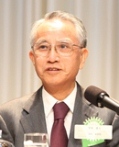A Psychosomatic Analysis on the Mystery of Pain
July 11, 2012
Mr. Hiraki Hideto
The Directer of Clinic, Hiraki Clinic
 ��Definition of pain
��Definition of pain
��The International Association for the Study of Pain defines pain as ��an unpleasant sensory and emotional experience associated with actual or potential tissue damage, or described in terms of such damage.�� We should note that this definition is a broad interpretation including emotional and psychological effects of pain, not just a sensory disorder.
��Pain is divided into two categories: acute pain that can be eliminated immediately by treating the underlying cause, and chronic pain that lasts for more than 3-6 months.
��Epidemiology
��There is no detailed survey on the number of patients suffering from chronic pain. In 2006, Dr. Hattori from the Oita University, Faculty of Medicine, conducted an internet survey to 30,000 subjects. Quoting from its findings, there were 17 million people suffering from chronic pain in Japan, mainly in the lower back, shoulders and head. They often opt for physiotherapy visiting orthopedists, internists, massage therapists and osteopaths. But 77.6% patients remain unsatisfied with their therapy.
��Psychogenic pain
��Psychogenic pain is the most troublesome among chronic pains, as most patients and medical experts are not aware of its nature. Psychogenic pain has the following characteristics:
��1) Chronic pain that lasts over 6 months.
��2) Lesion cannot be detected by detailed examinations conducted at two or more medical facilities.
��3) General painkillers do not work.
��4) The pain is peculiar and inexplicable.
��Therapy
��Unfortunately, there is no established therapy for psychogenic pain. A limited number of physicians provide therapy on a trial-and-error basis. Therapy is divided into two categories: pharmaceutical therapy and psychotherapy.
��1) Pharmaceutical therapy
��Among the 15,000 drugs approved in Japan, 270 drugs have analgesic effect yet there is no specific drug for psychogenic pain. General painkillers are almost non-effective. Although we prescribe certain kinds of antidepressant and tranquilizer that seem effective, pharmaceutical therapy must be coupled with psychotherapy in order to treat a patient successfully.
��
��2) Psychotherapy
Psychogenic pain has strong correlation with the personality and psychology of each patient. Patients tend to suffer from frequent relapses unless they manage to change their way of thinking and perception.
��Psychotherapy includes ��cognitive therapy,�� ��counseling�� or ��Morita therapy.�� Whichever therapy patients choose, we must note that doctors give a significant impact to patients.
��In 1930, Dr. Michael Balint in the UK established the ��Balint therapy.�� His famous phrase ��the drug named ��doctor�ǡ� emphasized a doctor himself/herself could be a powerful medication. Medicine comes with a written statement on its efficacy as well as side effects. When it comes to doctors, however, patients are hardly informed on their side effects. Dr. Balint highlighted such problematic doctor-patient relationship and suggested ��doctors must be aware that their heedless words and behavior can give negative impact on patients.��
��3) Goal of therapy
��The most important element in therapy is that the patient and the doctor share the same goal. Majority of patients aim at totally eliminating the pain, but I must say such ambitious goal could undermine effective therapy. Many patients wish to start working again when they get rid of their pain. Yet, their social reintegration is often prolonged as they wait for the pain to disappear completely. Today, the front-line orthopedists in the US advocate the ��stay active�� campaign, aiming to ��maintain an active life�� for patients with chronic pains. Its underlying philosophy is shared with ��Morita therapy,�� the first psychotherapy established in Japan 90 years ago. This therapy directs patients to accept life as it is, take action responsively and stay active regardless of their symptoms and pains.
��
��Revolutionary knowledge on back pain
��Today, revolutionary knowledge is acquired on back pain treatment. Dr. Eugene Carragee of Stanford University made a five-year-survey on 100 patients with minor back pain and discovered that the risk of having serious back pain for psychologically unstable people was 30 times greater than that of mentally stable people. Dr. Vania Apkarian of Northwestern University conduced research using MRI on patients suffering from severe chronic pain and identified the part in the brain that detects pain. Ordinary pain is detected at the thalami, while psychogenic pain is detected at the frontal lobe. Further research clarified that abnormal activity in the prefrontal lobe, a part that controls negative emotions of stress or anxiety, could trigger chronic pain.
��In Japan, Dr. Shin��ichi Kikuchi, President of Fukushima Medical University and also President of the International Society for the Study of the Lumber Spine, clarified that ��only 15% of the back pain can have clear diagnosis, while 85% remain unexplained non-specific low back pain.��
��Conclusion
��You feel pain when there is something wrong. But you can also feel painful without any problem when you suffer from psychogenic pain. Patients suffering from pain might not be able to eliminate it completely, but I encourage them to accept pain and try to stay active in life.
��The world is undergoing rapid change, but our mind remains intact over many decades. Everyone has a mind but sometimes it is hard to control. The ��mystery of pain�� is rooted in the ��mystery of our mind.��
��Let me conclude my speech by quoting the words of Arnold Toynbee: ��People in modern times know everything, except about themselves.��